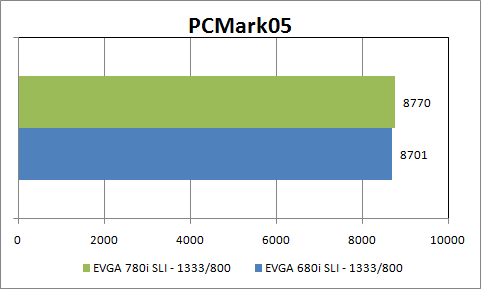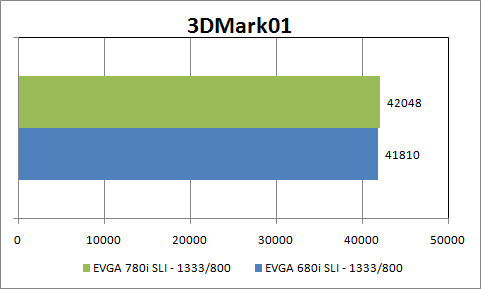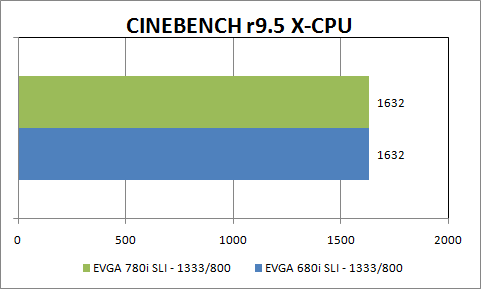NVIDIA 780i: Evolution Plus Triple SLI
by Wesley Fink on December 17, 2007 9:00 AM EST- Posted in
- CPUs
General System Performance
The PCMark05 benchmark, developed by Futuremark, is useful for determining overall system performance for the typical home computing user. This tool provides both system and component level benchmarking results utilizing subsets of real world applications or programs. The test is useful for providing comparative results across a broad array of GPU, CPU, hard disk, and memory configurations along with multithreading results. In this sense, we consider the PCMark benchmark to be both synthetic and real world in nature while providing consistency in our benchmark results.

As expected, the performance difference between 780i and 680i is less than 1%, which is well within the confidence levels of this benchmark. Essentially both chipsets perform the same.
General Graphics Performance
The 3DMark series of benchmarks from Futuremark are among the most widely used tools for benchmark reporting and comparisons. Although the benchmarks are very useful for providing apple to apple comparisons across a broad array of GPU and CPU configurations they are not a substitute for actual application and gaming benchmarks. In this sense, we consider the 3DMark benchmarks to be purely synthetic in nature but still valuable for providing consistent measurements of performance.
The later 3DMark tests, such as 3DMark05, are almost entirely influenced by the GPU under test, though CPU performance plays a larger role in 3DMark06. Results should be extremely close in this instance since we use the same graphics card for testing on both systems. 3DMark01 is still widely used because it is a useful overall system performance test. System, CPU, and memory configurations affect results far more than in later 3DMark benchmarks.


3DMark06 results are all but identical, while 3Dmark01 shows performance results within about half a percent. Performance in these general graphics benchmarks is therefore the same.
Rendering Performance
The CINEBENCH 9.5 benchmark heavily stresses the CPU subsystem while performing graphics modeling and rendering. We utilize the standard benchmark demos in each program along with the default settings. CINEBENCH 9.5 features two different benchmarks with one test utilizing a single core and the second test showcasing the power of multiple cores in rendering the benchmark image. We use the multi-core benchmark to compare the 780i and 680i.

Results in the SMP rendering tests are the same for the 680i and 780i.
Tests with these four general performance benchmarks confirm that the performance of the 780i and 680i is essentially the same when using equivalent systems. This is what we expected given the fact that NVIDIA clearly states there is no change in the micro-architecture of the 780i compared to the 680i.
Recent graphics testing has already established that current video cards do not even come close to saturating the current PCIe 1.1 bus. Future video cards and applications will be more demanding, but it will likely be some time before we see a measurable performance advantage with PCIe 2.0.










23 Comments
View All Comments
Wesley Fink - Tuesday, December 18, 2007 - link
As mentioned in the article we also have a 780i overclocking review coming to answer your questions in more detail. This was a chipset launch, and there was little point of doing game tests when performance is the same as the well-tested 680i. The benchmarks we did run were just a sanity test to determine if 680i/780i really did perform the same, and they did.Anand is delving into Triple SLI performance and Gary Key will be doing an article on overclocking the 780i with Penryn. I will be following up later with an ESA system review, although the ESA test platform is actually is powered by a 680i.
All of these reviews were planned to work together, but got sidetracked in our server crisis and image meltdown. You should see Anand's Gaming/Triple SLI review tomorrow.
Frumious1 - Tuesday, December 18, 2007 - link
Since I don't have behind the scenes info, I'm left to conjecture. Maybe nVidia sent the hardware on Friday and you didn't have time, or maybe there were a bunch of testing issues. HardOCP seemed to be pretty unimpressed, but then what's new? Since this is a chipset launch article, with a few new features, I just felt we should see testing to check out how those features impact performance.SLI support, you've got SLI/Tri-SLI testing from Anand but that's with 8800 Ultra cards. It was a nice article, covering that area, but what about PCIe 2.0? Seems to be a part of the chipset, and some sanity checks with 8800GT SLI on both 680i and 780i would have been able to say if there was any actual difference. That wasn't done anywhere yet. That is not a motherboard review, or a Penryn overclocking article - that is a part of the chipset.
ESA is a system thing as I understand it, so it makes sense to wait for a complete system review. Overclocking is also somewhat part of a chipset review, but as demonstrated in teh past it's also very motherboard specific. Otherwise why is it that Asus, DFI, etc. do better than some others?
What it comes down to is that there appears to be one truly new and unique feature for 780i: PCIe 2.0 support. Well, and Penryn support, but that seems to be something that can be addressed on new 680i boards since 680i ~= 780i - nF200. You totally missed that in this "chipset launch review" by not even touching that with any form of benchmark. Show us some games, with PCIe 2.0 graphics cards, and show us whether there's any difference or not. That's what I want from an article looking at a new chipset - a focus on what's actually new.
Wesley Fink - Tuesday, December 18, 2007 - link
We said in the review that the current top PCIe 2.0 cards like the 8800 GT do not even come close to saturating the past PCIe 1.1 bus. Since PCIe 2.0 is just a bandwidth increase, and nothing else, why would you expect it to make any difference at all in the performance of the 8800 GT? That was alreay a known before the chipset review.Anand tested with the 8800 Ultra because the 8800 GT will NOT work in triple SLI. You must have a dual SLI connector for triple SLI, and the 8800GT doesn't have a dual connector. That is very well-explained in Anand's 3-way SLI article, and only the near obsolete 8800GTX and 8800Ultra have the dual connector.
Frankly we're always ready to test new technology, but the best I can figure the 780i SPP is a 680i SPP with the 16 lane PCIe connect overclocked to 4.5 GT/s. nVidia couldn't even quite reach the 5.0 GT/s level that is the PCIe 2.0 spec, but it really doesn't matter since PCIe 2.0 makes no difference today - it might in the future. The MCP is a 2-generations ago 570 MCP.
Changing an ID string and stamping a chip with a new name does not make it new technology. The chipset works well and will fill in for a short period until nVidia introduces their new chipset that will support 1600 FSB and DDR3.
Wesley Fink - Tuesday, December 18, 2007 - link
We said in the review that the current top PCIe 2.0 cards like the 8800 GT do not even come close to saturating the past PCIe 1.1 bus. Since PCIe 2.0 is just a bandwidth increase, and nothing else, why would you expect it to make any difference at all in the performance of the 8800 GT? That was alreay a known before the chipset review.Anand tested with the 8800 Ultra because the 8800 GT will NOT work in triple SLI. You must have a dual SLI connector for triple SLI, and the 8800GT doesn't have a dual connector. That is very well-explained in Anand's 3-way SLI article, and only the near obsolete 8800GTX and 8800Ultra have the dual connector.
Frankly we're always ready to test new technology, but the best I can figure the 780i SPP is a 680i SPP with the 16 lane PCIe connect overclocked to 4.5 GT/s. nVidia couldn't even quite reach the 5.0 GT/s level that is the PCIe 2.0 spec, but it really doesn't matter since PCIe 2.0 makes no differenc today - it might in the future. The MCP is a 2-generations agao 570 MCP.
Changing an ID string and stamping a chip with a new name does not make it new technology. The chipset works well and will fill in for a short period until nVidia introduces their new chipset that will support 1600 FSB and DDR3.
Frumious1 - Wednesday, December 19, 2007 - link
I understand why Anand used 8800 Ultra cards. That was the point of his article: Tri-SLI. Not chipset or anything else. And I'm guessing you're right that PCIe 2.0 is nothing and won't impact performance for probably years - in fact, I bet PCIe x8 is sufficient for everything we currently do, since ATI and nVidia use bridge connections for most card-to-card communications in SLI/CF. I'd still love to see an actual test that proves this is the case.You and I and everyone else can assume all we want, but without a test we don't actually KNOW. Since the only PCIe 2.0 cards are 8800GT (and the new GTS) and 3850/3870, and since this is an nVidia chipset, I just thought it would be good to prove and not guess at what impact PCIe 2.0 has. Maybe nVidia does benefit in some situations on SLI setups. Not likely, but maybe.
Frumious1 - Tuesday, December 18, 2007 - link
PS - if you don't have two 8800 GT cards floating around for PCIe 2.0 tests, you need to slap nVidia! Besides Penryn, that's the only feature worth testing on the new chipset.masteryoda34 - Monday, December 17, 2007 - link
This is probably the most disappointing recent motherboard launch from Nvidia. The only reason I could see buying this over an Intel P35 or X38 is for the SLI support. It's unfortunate they didn't use a new chipset. Basically the same as when they did NF4 to NF5, no new features just processor support.anandtech02148 - Monday, December 17, 2007 - link
with all these bulky graphic card pile up.. why dont' they just make a dongle connector for all the Sata ports.that or i need someone with sausage fingers that can reach all the sata ports.
and i guess the graphic guys realy want to rub out the audio cards.
Wesley Fink - Monday, December 17, 2007 - link
Actually the SATA ports are still accessible even with 3 double width graphics cards in Triple SLI. If you click to blow up the motherboard images on p.6 you will see the SATA ports are located so they fall just to the right of the first PCIe slot.You're right about audio though. Fortunately the on board is hi-def Azalia, but many will want a better audio card for 3-way SLI gaming.
customcoms - Monday, December 17, 2007 - link
Should be 650i, not 750i. Page 3.